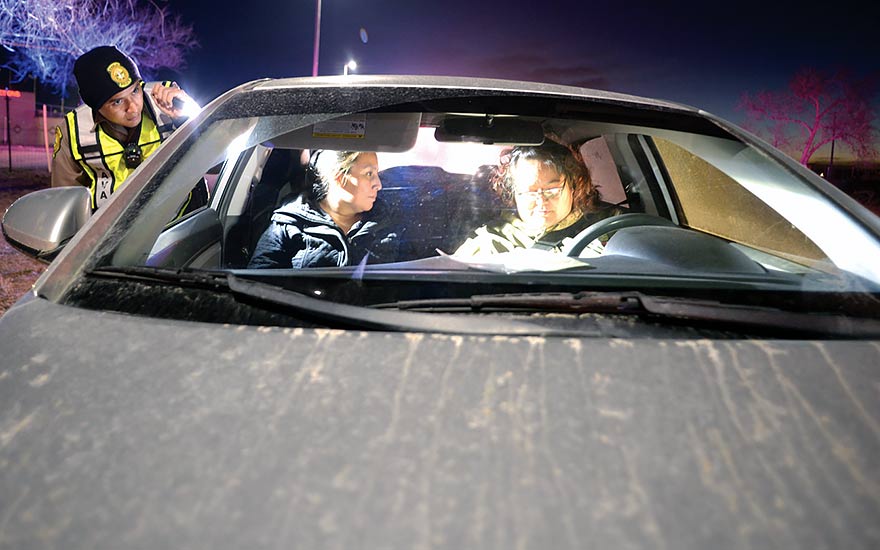
‘It’s the threat you don’t see …’

Navajo Times | Donovan Quintero
Adrienne Joe, right, and Carla Morgan play the roles of passenger and driver with drugs in their vehicle and are searched by police cadet Joseph Locaspino on Tuesday in Chinle. Locaspino will join the Window Rock District if he compltes training. The cadets will graduate on Feb. 22 in Chinle.
Police cadets undergo training scenarios to test reactions, performance
CHINLE
The training scenario is this: A reckless driver is forcing oncoming motorists to pull off the highway. The incident is in the middle of night, in the middle of nowhere on the reservation.
Navajo Nation Police cadets Joshua Martinez and Kolby Begay witness the incident and perform a traffic stop.
Martinez and Begay inform the dispatcher the location of the traffic stop and give a description and plate number of the vehicle before collecting information from the driver, otherwise known as developing probable cause.
The cadets’ evaluator, a 21-year veteran, Sgt. Lamar Martin with the Crownpoint Police District, observes their every move. After a traffic citation is issued and the traffic stop is completed, Martin gives instruction on the use of lights.
“It’s the threat that you don’t see that will hurt you regardless if it’s daytime or nighttime,” Martin said. I’ve been involved in two shootings and they were at nighttime. Our most recent officer that passed – Houston (Largo) – was at nighttime. Nighttime is scary. Use as much light that you have available.”
“I didn’t think about that,” said Martinez, who will be assigned to Tuba City if he completes the academy. “It makes more sense now with the spotlighting everything before you come onto a scene.”
The traffic scenario was one of many the 16 remaining Navajo Nation police cadets were graded on during a four-day training exercise known as Comprehensive Assessment of Practical Skills, said Lt. Emmett Yazzie, the training academy’s commander, on Tuesday evening. Yazzie said cadets are required to pass CAPS in order to graduate.
“The four-day exercise encompasses everything they learned, from laws of arrest, search and seizure, constitutional law, Miranda, probable cause, reasonable suspicion, Title 17, Title 14, how to make a traffic stop, which side to approach when you make an arrest, what of handcuffing will you be using,” Yazzie said.
“I mean, we run them through a whole gambit,” he said. “All those many classes and courses that they took, we’re kind of saying, ‘Everything you learned, let’s apply it out in the field.’ So, that’s what they’re doing this week.’”
The cadets will graduate Feb. 22 at the Chinle Community Center, Yazzie said.
At another training where a person is observed in an area known for burglary, evaluator Rodney Slim observes cadet Julianna Begay as she arrests and places a suspect into her police unit. The suspect, almost a foot taller than her, is carefully placed into the backseat while handcuffed.
Begay retrieved a handgun, a fake, from the suspect, played by Shiprock Police Dispatcher McArthur Begay, when she searched him. After completing the scenario, Slim gives his input.
“This is a pass,” he said. “He kept putting his hands in his pocket. You did the right thing to pat him down. Most burglaries involve some kind of weapon, like a knife, screwdriver, or a handgun.”
Slim then mentioned Navajo Nation criminal codes Begay could charge the man with regarding the firearm. He gave her additional instructions.
“What does everybody like to do out here?” he said. “They like to go, shoot and carry weapons. They’ll carry it on them. You gotta know when you can take it and when you can’t, and the keyword on that one is ‘loaded, loaded.””
Slim, like Martin, emphasized using lights. Begay smiled and nodded as she listened to Slim.
“It’s fun, it’s a learning experience,” Begay said, who will be joining the Chinle District if she passes CAPS. “I’m excited. Everything that’s being said to us, the critiques and all that, I take it to heart because it is something we will be falling back on when we get out on the road.”
Martin returned to the academy and began writing down his evaluation.
“Our objective that we need to meet: a Cadet officer will demonstrate and main self-composure under verbal attack, demonstrate and take control of an escalating situation,” he said. “Demonstrate to clearly explain the consequences of failing to signing a citation. Demonstrate the ability to effectively make a timely decision. After 26 weeks in the academy they’re making good progress.”
Graduation is open to the public and will begin at 10 a.m.
To read the full article, pick up your copy of the Navajo Times at your nearest newsstand Thursday mornings!
Are you a digital subscriber? Read the most recent three weeks of stories by logging in to your online account.








 Highway 264,
Highway 264, I-40, WB @ Winslow
I-40, WB @ Winslow